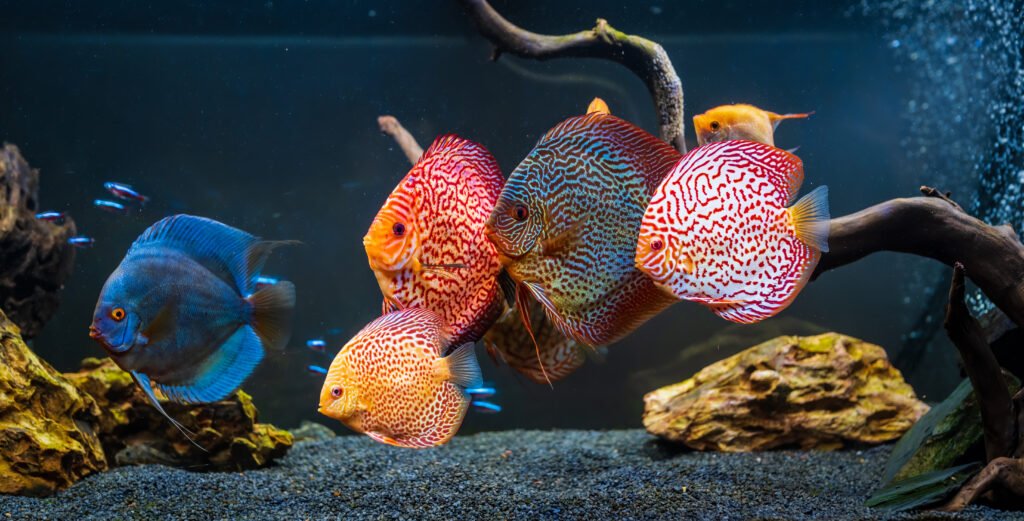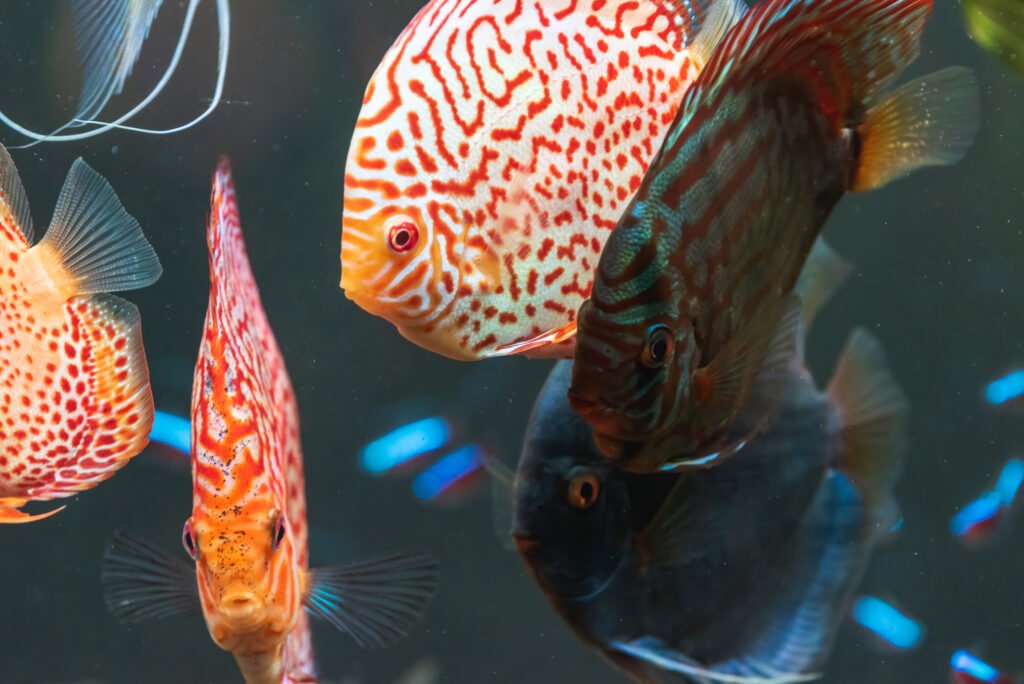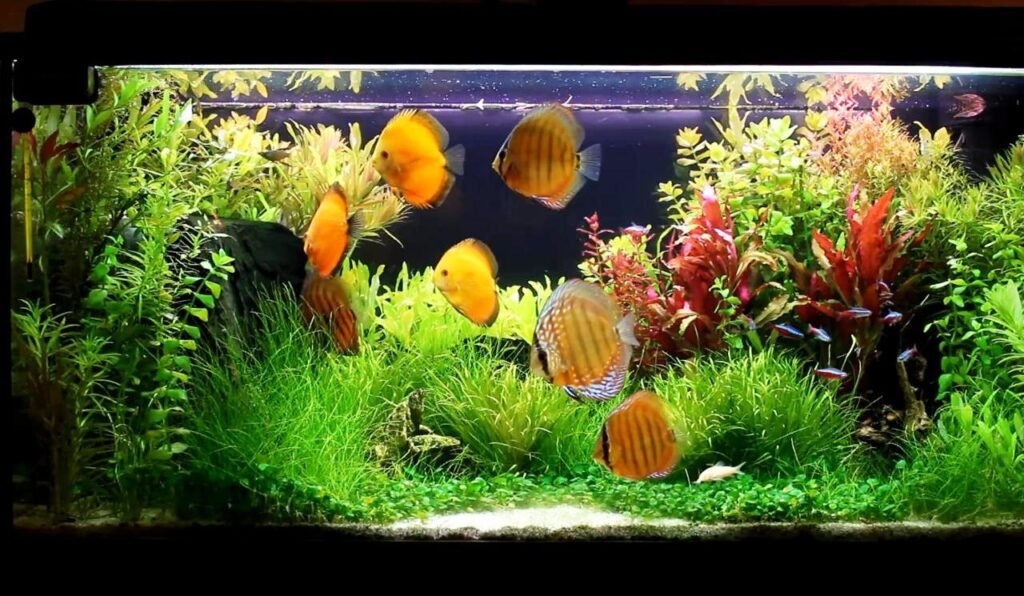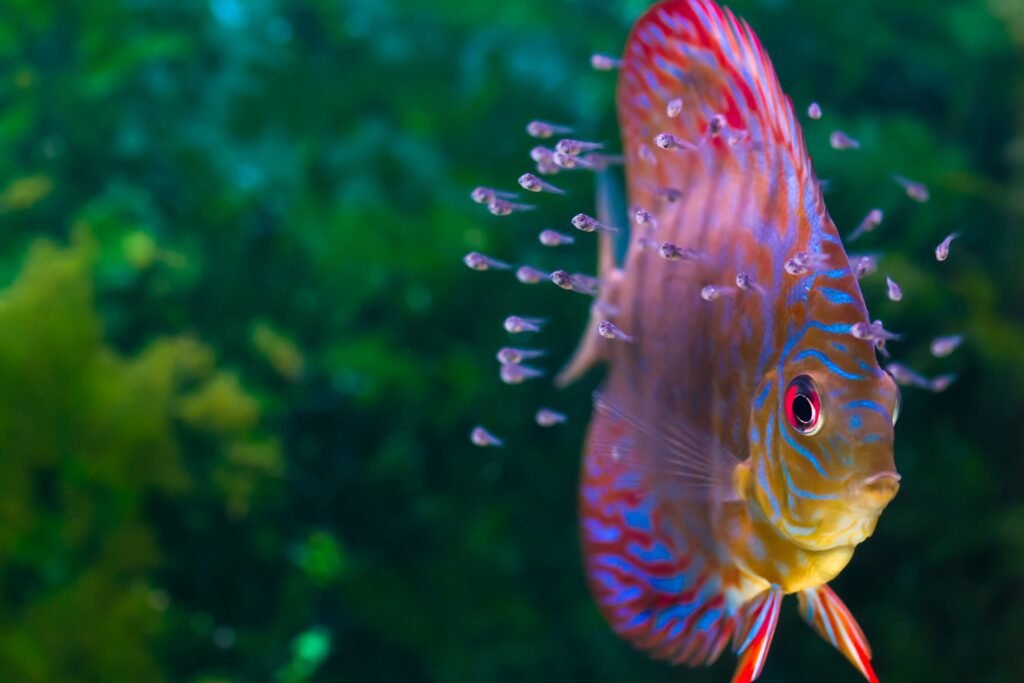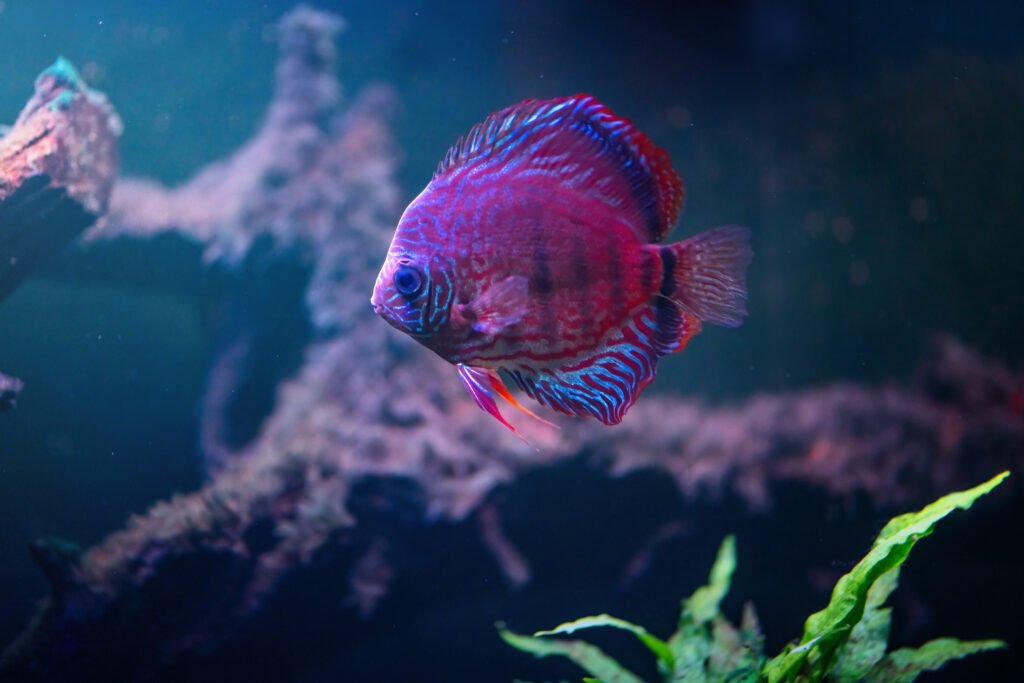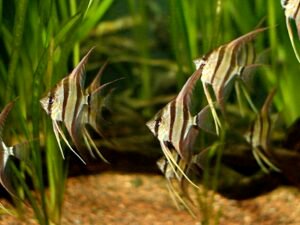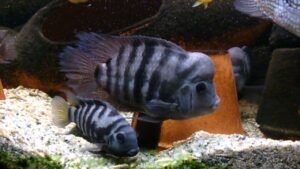Discus Fish: The Ultimate Guide
Everything You Need to Know
Quick Facts
Scientific Name: Symphysodon spp.
Year Described: 1840
Other Names: Pompadour Fish, King of the Aquarium
Kingdom: Animalia
Classification: Actinopterygii
Order: Cichliformes
Family: Cichlidae
Genus: Symphysodon
Origins: Amazon River Basin in South America
Max Size: 6-8 inches (15-20 cm) in diameter
Temperament: Peaceful, can be shy and sensitive
Aquarium Level: Middle to Bottom
Difficulty: Intermediate to Advanced
Shoaling: Yes, best kept in groups of 5 or more
Best Keep As: Species-only tank or with peaceful, similarly-sized fish
Diet and Feeding: Omnivorous, requires high-quality foods and frequent feedings
Reproduction: Egg layers, parents care for the eggs and fry
Average Lifespan: 10-15 years with proper care
Water Parameters:
Water Type: Freshwater
pH: 6.0-7.5
GH: 1-6 degrees of general hardness
KH: 1-4 degrees of carbonate hardness
Ideal Temperature: 82-86 degrees Fahrenheit (28-30 degrees Celsius)
Introduction
Discus fish are among the most stunning and sought-after freshwater aquarium fish. Known for their vibrant colors, unique patterns, and graceful movements, these South American cichlids have captivated the hearts of aquarists worldwide. Native to the Amazon River basin, discus fish have evolved to thrive in the soft, acidic waters and warm temperatures of their natural habitat.
Keeping discus fish in the home aquarium can be a rewarding experience, but it does require dedication, knowledge, and attention to detail. These fish are more sensitive to water quality and parameter fluctuations compared to many other popular aquarium species. However, with proper care and a well-maintained environment, discus fish can flourish and provide their keepers with years of enjoyment.
In this comprehensive guide, we’ll explore the fascinating world of discus fish, covering their origins, varieties, care requirements, and breeding. Whether you’re a seasoned aquarist looking to add these beautiful fish to your collection or a beginner interested in learning more about these aquatic gems, this guide will provide you with the information you need to successfully care for and appreciate discus fish.
Varieties
One of the most exciting aspects of keeping discus fish is the wide array of varieties available in the aquarium trade. Through selective breeding, a stunning range of colors, patterns, and shapes have been developed, each with its own unique charm and appeal. Some popular varieties include:
- Wild Discus: These are the original discus fish found in their natural habitats, such as the Heckel discus and the green discus. They display more natural colors and patterns, often with earthy tones and subtle striations.
- Pigeon Blood Discus: This variety is highly sought-after for its deep, rich red coloration, which is often accentuated by black or white spots. The intensity of the red can vary, with some specimens displaying a almost fluorescent hue.
- Blue Diamond Discus: As the name suggests, these discus fish are characterized by their iridescent blue scales that shimmer and catch the light. The blue is often contrasted by striking red eyes, creating a truly mesmerizing appearance.
- Snakeskin Discus: Named after their intricate, snake-like patterns, these discus fish feature a network of dark lines and spots on a lighter background. The patterns can range from bold and contrasting to more subtle and intricate.
- Turquoise Discus: These discus fish showcase a stunning blend of turquoise, blue, and green hues, often with a metallic sheen. Some specimens may also display hints of red or yellow, adding to their visual appeal.
- Solid Color Discus: As the name implies, these discus fish are bred to display a single, solid color throughout their body. Popular solid color varieties include red, blue, yellow, and white.
- Leopard Discus: This variety features a base color of yellow or orange, overlaid with dark spots or patches resembling a leopard’s coat.
- Marlboro Red Discus: Known for their vibrant, deep red coloration, Marlboro Red discus are a highly sought-after variety. The intensity of the red is often uniform throughout the body.
In addition to these popular varieties, there are countless other color morphs and patterns available, each with its own unique appeal. Many discus enthusiasts enjoy collecting multiple varieties to create a stunning display in their aquariums.
Care Guide
Providing proper care for discus fish is essential to ensure their health, vibrance, and longevity. Here are the key aspects of discus fish care:
Tank Size and Setup:
Due to their size and sensitivity, discus fish require a spacious aquarium to thrive. A minimum tank size of 55 gallons is recommended for a small group of juvenile discus, while adults will need an aquarium of at least 75 gallons or larger. A bigger tank is always better, as it provides more stable water conditions and allows for better swimming space.
When setting up a discus tank, it’s essential to create a clean, well-maintained environment. Discus fish are sensitive to poor water quality and can quickly become stressed or ill if exposed to high levels of ammonia, nitrite, or nitrate. A robust filtration system, such as a canister filter or a sump, is necessary to maintain excellent water quality.
Decorating a discus tank should be done with care, as these fish appreciate open swimming spaces and minimal decor. Smooth substrates like sand or fine gravel are recommended to prevent injury to their delicate skin. Driftwood, rounded rocks, and live plants can be used to create a natural, aesthetically pleasing environment without overcrowding the tank.
Water Parameters:
Maintaining stable and appropriate water parameters is crucial for the health and well-being of discus fish. These fish are native to the soft, acidic waters of the Amazon River basin and require specific conditions to thrive in captivity.
Temperature: Discus fish prefer warm water, with an ideal temperature range of 82-86°F (28-30°C). A reliable aquarium heater and thermometer are essential to maintain a consistent temperature.
pH: The ideal pH range for discus fish is between 6.0 and 7.5. A slightly acidic pH is preferred, as it mimics their natural habitat. Regular testing and adjustment of pH levels may be necessary to maintain stability.
Hardness: Discus fish thrive in soft water with low levels of dissolved minerals. The recommended general hardness (GH) range is 1-6 degrees, while the carbonate hardness (KH) should be between 1-4 degrees. Using a reverse osmosis (RO) system or incorporating peat filtration can help achieve the desired hardness levels.
Regular water changes of 10-25% per week are essential to remove accumulated waste and replenish essential minerals. Maintaining stable water parameters through consistent maintenance is key to keeping discus fish healthy and stress-free.
Diet and Feeding:
Providing a balanced, nutritious diet is essential for the growth, coloration, and overall health of discus fish. In the wild, these fish are omnivorous, feeding on a variety of small invertebrates, plant matter, and detritus.
In the home aquarium, discus fish require a varied diet consisting of high-quality foods. Commercial discus pellets or flakes specifically formulated for their nutritional needs should form the base of their diet. These foods are designed to provide the necessary proteins, vitamins, and minerals for optimal health.
Supplementing the staple diet with regular offerings of frozen or live foods is highly recommended. Bloodworms, brine shrimp, and beef heart are popular choices that provide additional protein and encourage natural foraging behaviors.
Vegetable matter should also be included in the discus diet to provide essential fiber and nutrients. Blanched spinach, lettuce, or spirulina-based foods can be offered a few times a week to round out their dietary needs.
Discus fish, especially juveniles, benefit from frequent feedings. Young fish should be fed small amounts 4-5 times per day, while adults can be fed 2-3 times daily. Adjusting the feeding frequency and portion sizes based on the fish’s age, size, and appetite is essential to prevent overfeeding and maintain good water quality.
Tank Mates:
When selecting tank mates for discus fish, it’s crucial to choose species that are peaceful, non-aggressive, and share similar water requirements. Discus fish are generally shy and can become stressed or intimidated by boisterous or aggressive tank mates.
Some suitable tank mates for discus fish include:
- Other discus fish: Keeping a group of discus fish together is often the best choice, as they are social creatures that thrive in the company of their own species.
- Peaceful tetras: Small, peaceful tetra species like cardinal tetras, rummy nose tetras, and ember tetras can make good companions for discus fish.
- Dwarf cichlids: Certain dwarf cichlid species, such as Apistogramma and Mikrogeophagus, can coexist peacefully with discus fish.
- Corydoras catfish: These peaceful bottom-dwellers can help keep the substrate clean and add visual interest to the discus tank.
It’s essential to avoid keeping discus fish with larger, more aggressive species that may outcompete them for food or harass them. Careful research and consideration should be taken when choosing tank mates to ensure a harmonious and stress-free environment.
Breeding
Breeding discus fish is a rewarding and fascinating experience for dedicated aquarists. However, it does require specialized knowledge, equipment, and a significant investment of time and resources. Here are some key aspects of discus breeding:
Pair Formation:
Discus fish are monogamous and form strong pair bonds. When breeding discus, it’s essential to allow them to choose their own partner rather than forcing a pair together. This natural selection process increases the chances of successful breeding and ensures better parental care.
To encourage pair formation, start with a group of young, healthy discus fish in a spacious tank. As they mature, you’ll notice certain individuals gravitating towards each other, displaying courting behaviors such as swimming side by side and cleaning a potential spawning site together. Once a pair has formed, they can be moved to a dedicated breeding tank.
Breeding Tank Setup:
Setting up a proper breeding tank is crucial for successful discus breeding. A bare-bottom tank with a volume of at least 50 gallons is recommended, as it allows for easier maintenance and monitoring of the eggs and fry.
The breeding tank should have soft, acidic water with parameters similar to those in the main discus tank. A sponge filter or a small, gentle canister filter can provide necessary filtration without creating excessive flow that may disturb the eggs or fry.
Include a flat, vertical surface such as a breeding cone or a piece of smooth driftwood for the discus pair to lay their eggs on. Discus prefer to spawn on vertical surfaces, so providing an appropriate structure is essential.
Spawning Process:
When a discus pair is ready to spawn, they will intensify their cleaning behavior around the chosen spawning site. The female will lay her eggs on the surface, and the male will follow closely behind to fertilize them. Discus are substrate spawners, meaning they do not mouthbrood like some other cichlid species.
After spawning, the discus parents will diligently care for their eggs, fanning them to provide oxygen and removing any unfertilized or fungus-infected eggs. This parental care is crucial for the survival and development of the offspring.
Fry Care:
Once the eggs hatch, the discus fry will initially feed on their yolk sacs for several days. During this time, the parents will continue to care for them, guarding them and keeping the area clean.
As the fry become free-swimming, they will start to feed on mucus secreted from the skin of both parents. This mucus, often referred to as “discus milk,” is rich in nutrients and antibodies that help the fry grow and develop their immune systems.
To support the growth of the fry, gradually introduce small, nutrient-dense foods such as newly hatched brine shrimp, microworms, or commercial fry foods. As the fry grow larger, they can be transitioned to finely crushed flakes or small pellets.
Regular water changes and excellent water quality are essential for the health and development of discus fry. As they grow, the fry can be gradually acclimated to the water parameters of the main discus tank and eventually integrated with the adult population.
Challenges and Considerations:
Breeding discus fish is not without its challenges, and it requires dedication, patience, and a willingness to learn and adapt. Some common challenges include:
- Encouraging pair formation and spawning
- Maintaining excellent water quality in the breeding tank
- Providing appropriate nutrition for the fry
- Preventing fungal or bacterial infections in eggs and fry
- Managing aggression between breeding pairs or towards other tank mates
It’s essential to research and understand the specific requirements and challenges associated with breeding discus fish before attempting to do so. Joining online forums, local aquarium clubs, and seeking advice from experienced breeders can provide invaluable knowledge and support throughout the breeding process.
Conclusion
Discus fish are truly remarkable creatures that have captured the hearts and imaginations of aquarists worldwide. With their stunning colors, unique personalities, and graceful movements, these fish are a true testament to the beauty and diversity of the aquatic world.
Successfully keeping and caring for discus fish requires dedication, knowledge, and a commitment to providing the best possible environment for their health and well-being. By understanding their specific needs, creating a well-maintained tank, and offering a balanced diet, discus fish can thrive and bring immense joy and satisfaction to their keepers.
For those who are willing to go the extra mile, breeding discus fish can be an incredibly rewarding experience. Watching a pair bond, spawn, and care for their offspring is a fascinating journey that showcases the remarkable parental instincts and behaviors of these fish.
Whether you’re a seasoned aquarist or a beginner enchanted by the allure of discus fish, this guide aims to provide you with the knowledge and inspiration to embark on your own discus-keeping journey. With patience, perseverance, and a genuine love for these amazing fish, you can create a stunning aquatic display that showcases the true beauty and majesty of discus fish.
Remember, keeping discus fish is not just a hobby; it’s a commitment to providing the best possible care for these living, breathing creatures. By continually learning, asking questions, and connecting with the discus community, you can ensure a thriving and happy home for your discus fish.
So, whether you’re marveling at their mesmerizing colors, observing their fascinating behaviors, or delighting in the joy of successfully raising a new generation, discus fish are sure to leave a lasting impact on your life as an aquarist.
Here’s to the incredible world of discus fish and the passionate community of aquarists who dedicate themselves to their care and appreciation. May your journey with these remarkable fish be filled with wonder, discovery, and endless beauty.
Happy discus keeping!
Views: 8

